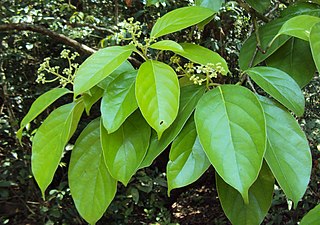
Calamansi, also known as calamondin, Philippine lime, or Philippine lemon, is an economically important citrus hybrid predominantly cultivated in the Philippines. It is native to the Philippines, Borneo and Sulawesi in Indonesia in Southeast Asia, as well as southern China and Taiwan in East Asia. Calamansi is ubiquitous in traditional Filipino cuisine. It is used in various condiments, beverages, dishes, marinades, and preserves. Calamansi is also used as an ingredient in Malaysian and Indonesian cuisines.

Ficus microcarpa, also known as Chinese banyan, Malayan banyan, Indian laurel, curtain fig, or gajumaru (ガジュマル), is a tree in the fig family Moraceae. It is native in a range from China through tropical Asia and the Caroline Islands to Australia. It is widely planted as a shade tree and frequently misidentified as F. retusa or as F. nitida.

Carica is a genus of flowering plants in the family Caricaceae including C. papaya, the papaya, a widely cultivated fruit tree native to the American tropics.

Elattostachys is a genus of about 21 species of trees known to science, constituting part of the plant family Sapindaceae.
Tovomita microcarpa is a species of flowering plant in the family Clusiaceae. It is found only in Peru.
Balaka microcarpa is a species of palm tree. It is endemic to Fiji, where it grows in dense forests. It is threatened by habitat loss.
Hydriastele microcarpa is a species of flowering plant in the family Arecaceae. It is found only in Fiji where it is threatened by habitat loss.
Aquilaria microcarpa is a species of plant in the Thymelaeaceae family. It is found in Indonesia and Singapore.
Eugenia microcarpa is a species of plant in the family Myrtaceae. It is endemic to Brazil.
Guatteria microcarpa is a species of plant in the Annonaceae family. It is endemic to Ecuador. Its natural habitat is subtropical or tropical moist lowland forests. It is threatened by habitat loss.
Gyrotaenia is a genus of plants in the family Urticaceae.
Gyrotaenia spicata is a species of plant in the family Urticaceae. It is endemic to Jamaica.

Mastixia is a genus of about 19 species of resinous evergreen trees, usually placed in the family Cornaceae. Its range extends from India through Southeast Asia and New Guinea to the Solomon Islands. Mastixia species have alternate or opposite simple broad leaves, many-flowered inflorescences, and blue to purple drupaceous fruits.
Maytenus microcarpa is a species of plant in the family Celastraceae. It is endemic to Jamaica.
Nectandra microcarpa is a species of plant in the family Lauraceae. It is found in Colombia and Peru.
Rudgea microcarpa is a species of plant in the family Rubiaceae. It is endemic to Peru.
Stenocarpus dumbeensis was a species of plant in the family Proteaceae. It was endemic to New Caledonia.

Acidonia microcarpa is a species of shrub in the plant family Proteaceae. It is the only species in the genus Acidonia. It is endemic to the south coast of the Southwest Botanic Province of Western Australia.

Paeonia officinalis, the common peony, or garden peony, is a species of flowering plant in the family Paeoniaceae, native to mainly mountainous areas of Southern Europe and introduced in Central and Western Europe and North America.

The Tamá National Natural Park is a national park located in the Tamá Massif of the Andean Region of Colombia, between the municipalities Toledo and Herrán, in the department of Norte de Santander, in the northeastern part of the Eastern Ranges of the Colombian Andes. One of the main attractions of the park is a 820-metre-high (2,690 ft) waterfall, one of the world's highest.








